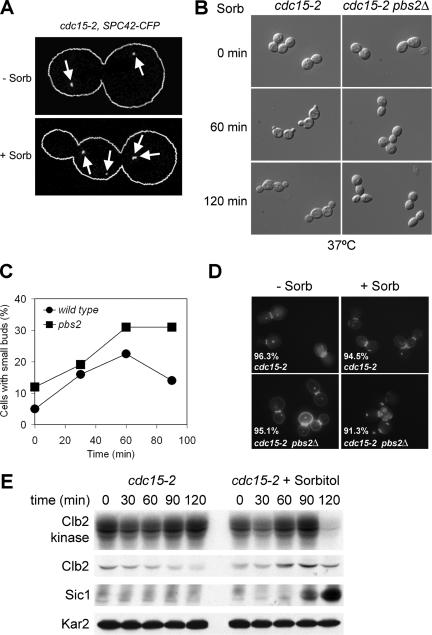Figure 2.
The HOG pathway drives exit from mitosis in MEN mutants in response to hypertonic stress. (A) Budding pattern as well as SPB number and distribution were analyzed in cdc15-2 (A9943) cells arrested in anaphase at restrictive temperature before (−Sorb) and 60 min after (+Sorb) addition of 1.5 M sorbitol. SPB number and distribution was monitored using CFP fused to the SPB protein Spc42 (localization indicated by white arrows). (B) cdc15-2 (A1674) and cdc15-2 pbs2Δ (A10710) cells were arrested in anaphase at 37°C (0-min time point), treated with 1.5 M sorbitol and then examined at the indicated time points by light microscopy using a DIC filter. (C) Wild-type (A1411) and pbs2Δ (A9610) cells were arrested in mitosis with nocodazole at 37°C. When the arrest was complete (after 150 min), cells were released from the block in the presence of 1.5 M sorbitol at 37°C, and the percentage of cells with small buds was determined. (D) cdc15-2 (A1674) and cdc15-2 pbs2Δ (A10710) cells were analyzed for their metabolic activity and cell wall integrity before and 150 min after osmotic stress (1.5 M sorbitol) at 37°C. The percentage of viable cells is indicated for each strain and conditions. (E) cdc15-2 (A1674) cells were arrested at 37°C for two hours. When the arrest was complete the culture was split, and one-half of the culture was maintained at 37°C and the other half was transferred into medium containing 1.5 M sorbitol. At the same time, 5 μg/ml α-factor was added to prevent sorbitol-treated cells from entering the next cell cycle. At the indicated times, samples were taken to determine the total amount of Clb2 and Sic1 protein as well as Clb2 kinase activity.

